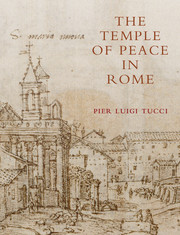Book contents
- Frontmatter
- Contents
- Preface
- Acknowledgments
- Abbreviations
- PART I The Templum Pacis in Context
- PART II Technical Analysis
- PART III The Great Hall in the Fourth Century
- PART IV AVLA DEI: The Basilica of Pope Felix IV (AD 526–530)
- PART V The Templum Pacis in the Middle Ages
- CHAPTER 13 The Christian Basilica from the Sixth Century until the Ninth Century
- CHAPTER 14 The Basilica during the Second Rebirth of Rome: The Twelfth Century
- CHAPTER 15 Funerary Monuments: Memento Mori
- PART VI Between Renaissance and Baroque
- PART VII Modern Excavations and Restorations
- Conclusion
- Notes
- Bibliography
- Index (Names)
- Index (Places)
CHAPTER 14 - The Basilica during the Second Rebirth of Rome: The Twelfth Century
from PART V - The Templum Pacis in the Middle Ages
Published online by Cambridge University Press: 06 January 2018
- Frontmatter
- Contents
- Preface
- Acknowledgments
- Abbreviations
- PART I The Templum Pacis in Context
- PART II Technical Analysis
- PART III The Great Hall in the Fourth Century
- PART IV AVLA DEI: The Basilica of Pope Felix IV (AD 526–530)
- PART V The Templum Pacis in the Middle Ages
- CHAPTER 13 The Christian Basilica from the Sixth Century until the Ninth Century
- CHAPTER 14 The Basilica during the Second Rebirth of Rome: The Twelfth Century
- CHAPTER 15 Funerary Monuments: Memento Mori
- PART VI Between Renaissance and Baroque
- PART VII Modern Excavations and Restorations
- Conclusion
- Notes
- Bibliography
- Index (Names)
- Index (Places)
Summary
AROUND 1150, THE HIGH altar of the Basilica of SS. Cosma e Damiano was decorated with a new ciborium. The Cosmatesque floor around it was at the level still visible today, and the floor of the great hall was already at + 113 cm, as attested to by the remains of first time, by the door of the the schola cantorum published here for the Romanesque bell tower (whose walls are preserved in the lower basilica and, further down, in the grotta), and by the great roundel in grey granite next to the passageway toward the rotunda.1 It should be considered that in the already- mentioned grotta, accessible from the rotunda but actually beneath the chapel of Felix II, is a small niche with a fresco dating from the end of the tenth century; given that the grotta was accessible, the extrados of its vault confirms the raised floor level of the basilica.
Although it cannot be excluded that the different parts of the basilica – rotunda, hall, and apse – had different levels (note the threshold still in situ stood in correspondence to the only surviving niche of the Severan age: cfr. Fig. 146), it is likely that the floors were raised at the same time. In any case, considering the floor around the high altar and the velarium in the rotunda, it appears that the raising of the floors was completed by the thirteenth century. This raising is linked to other events that modified the appearance of the basilica dramatically, and which might all be related to the new ciborium and to the consecration of the high altar during the papacy of Adrian IV (1154–1159): “In ecclesia sanctorum Cosme et Damiani maius altare lapide superposito illi lapidi quem beatus papa Gregorius consecraverat, propriis manibus mediante Quadragesima dedicavit” (Liber Ponti.ftcalis II 396).
- Type
- Chapter
- Information
- The Temple of Peace in Rome , pp. 695 - 732Publisher: Cambridge University PressPrint publication year: 2017

